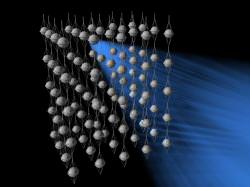You know what it’s like to get an X-ray done: you go to the doctor, get in a large machine, she puts on a lead vest, and X-rays shoot through your body, forming a picture of your skeletal structure. Well, using the IceCube neutrino detector – as well as other neutrino detectors to come – it might be possible to do something very similar to this, but to the Earth.
A collaborative team of physicists and geologists from around the world has proposed that with the construction of IceCube, a neutrino detector at the South Pole, it should be possible to get a very accurate picture of the Earth’s core using neutrinos that stream through the Earth from the other side. Their recent paper is entitled Imaging the Internal Structure of the Earth with Atmospheric Neutrinos.
Neutrinos are particles with very small mass that don’t interact with other types of matter very often. There are trillions of them streaming through your body this very second, but don’t worry: the chance that they will interact with any of the protons or neutrons that make up your body are very, very low. The higher the energy of the neutrino, the more likely it is to interact with a particle that has mass. When this happens a cascade of other particles is created, and a particle called a muon that is produced by this reaction can be detected.
Neutrino telescopes don’t look anything like your average viewing telescopes; rather, they are made up of a huge block of matter, usually water or ice. IceCube is just such a detector, made up of one cubic km of ice at the South Pole. There are small “strings” of detectors placed strategically in the ice to record the presence of muons from neutrino-particle interactions. The large mass of the detector increases the likelihood of finding the collisions between neutrinos and other particles.
The idea to use neutrinos as a way to image Earth’s interior has been around for more than 25 years, but IceCube is the first neutrino telescope with the ability to detect neutrinos at the energies necessary to give an accurate picture of the core.
Using IceCube to view the inside the Earth would increase our understanding of the “core-mantle transition” – where the Earth’s core meets the mantle – because this method is more accurate than methods currently used to estimate what the inside of the Earth looks like.
Dr. Francis Halzen of the University of Wisconsin Department of Physics, one of the co-authors of the research paper proposes, “we can see the transition “directly” and not infer it from some analysis of indirect data, such as data on Earth sound waves. The precision of our mapping is directly related to our angular resolution on the path taken through the Earth by a neutrino.”
Much like in an X-ray, some of the neutrinos coming through the Earth would be blocked by the dense core – like the Earth’s “skeleton” – while those streaming through the mantle, which is less dense, would be detected by IceCube.
Though the IceCube telescope is still under construction, it has already begun taking data, and will only continue to improve as more detectors are added to the ice.
Dr. Halzen said, “An unusual feature of IceCube is that we operate the partially deployed detector while we are constructing it. We have been collecting data relevant to this problem for more than 1 year and hope to run half the detector starting this February, i.e. after another construction season over the Antarctic summer that just started.”
The imaging is expected to be finished anywhere between the next 3 and 10 years.
Source: Arxiv Paper

